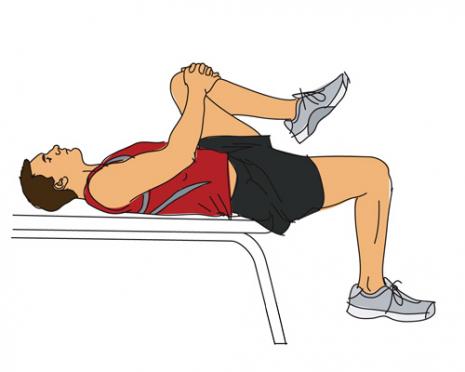Stabilizing The Pelvis, Using the Modified Kemps and Straight Leg Raise Tests And Post-isometric Relaxation (PIR)
SOURCE: Chiro.Org’s Low Back Pain Page
 |
Dr. Leonard Faye reminds us in Chapter 6 of Schafer’s text “Motion Palpation” that:
“In all low-back pain cases, it is essential to test for
hamstring, quadriceps, and psoas length.”
The picture on the left displays the positioning for the Modified Thomas Test. This test is is a very effective way to assess the length of 2 different muscles.
When the patient holds their knee to their chest, the following 2 things should become immediately apparent:
- If the psoas is of normal length, then the dependent thigh should be free to hang down 45° below the plane of the table. In this picture, the patient’s right psoas is significantly shortened.
- If the quadriceps are of normal length, the angle of the knee (between thigh and leg) should approximate 90°
If the psoas is shortened, it pulls the thigh into (some degree of) flexion, so the thigh cannot fully extend. This shortens your gait. Recalling that the origin of the psoas includes the lower thoracic vertebra, the lumbar segments I-IV, and the neighboring intervertebral discs, you can see why shortness would destabilize the lumbar and pelvic joints. Also… if the psoas is in contraction, the gluts may become inhibited by reciprocal inhibition.
If the quadriceps are shortened, it draws the leg into extension. Because portions of the quads originate on the pelvis, a shortened quads also distorts normal pelvic motion.
 |
The picture on the left displays the Straight Leg Raise (SLR) (although I fail to see the need for bondage). If the hamstrings are normal length, the leg should passively flex to at least 90°, without lifting sacrum off the table. Knowing that the hams originate on the ischial tuberosity, shortness of the hams can also distort pelvic mechanics.
Post-isometric Relaxation (PIR) is an effective and well-tolerated method for returning shortened muscles to normal resting length.
The Soviet Block countries first adopted using PIR on their Olympic athletes in the 70s. They found that after 6-12 treatments, athletes continued to maintain their improvements, even after 12 months. This is quite remarkable, considering that they continued to train at Olympic levels (numerous hours per day, day after day) for a whole year.
| PIR of the Psoas |
Read the rest of this article now!


Thank you for a great read, and a great reminder as to the muscular component of pelvic dysfunction.
Thank you so much for sharing. I’ve had so much success with athletes subject to injury improving their hip flexor’s flexibility to reduce further strain. They’ve also experienced better improved performance in vertical leap and sprint speed.
Checking Psoas is a huge problem I find all the time especially with people who have low back pain. Doing a psoas check is a great way to help these patients.